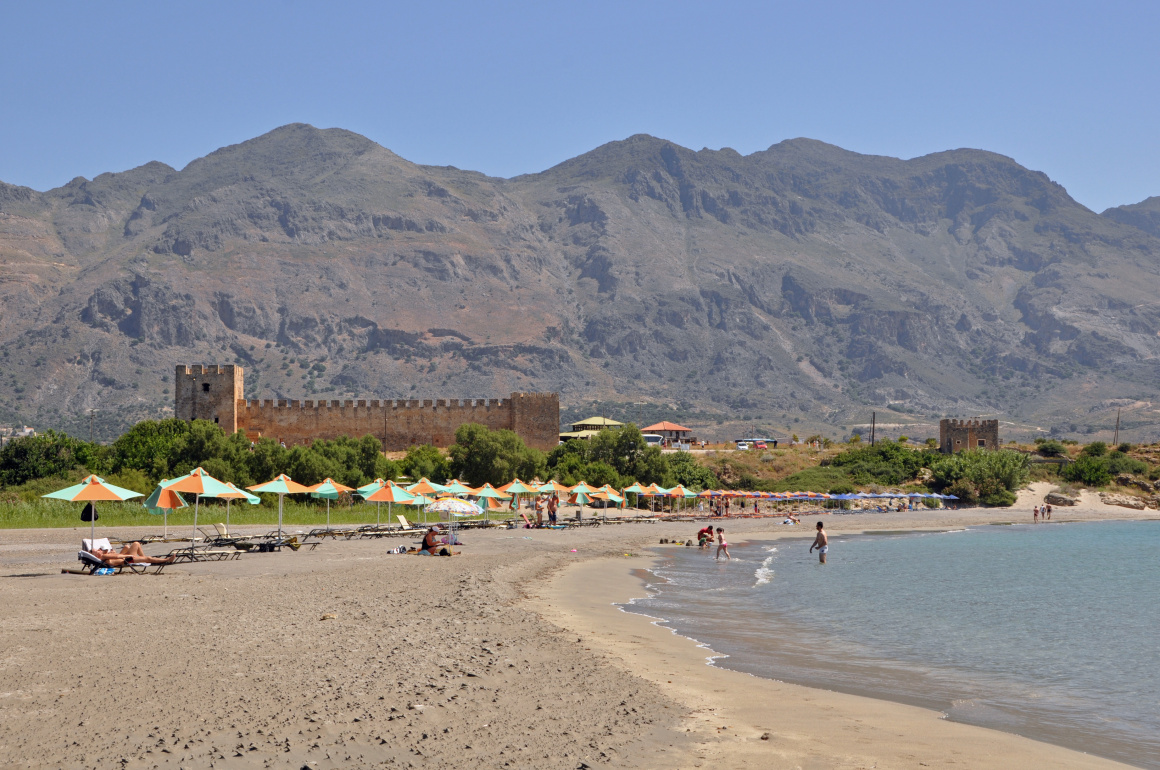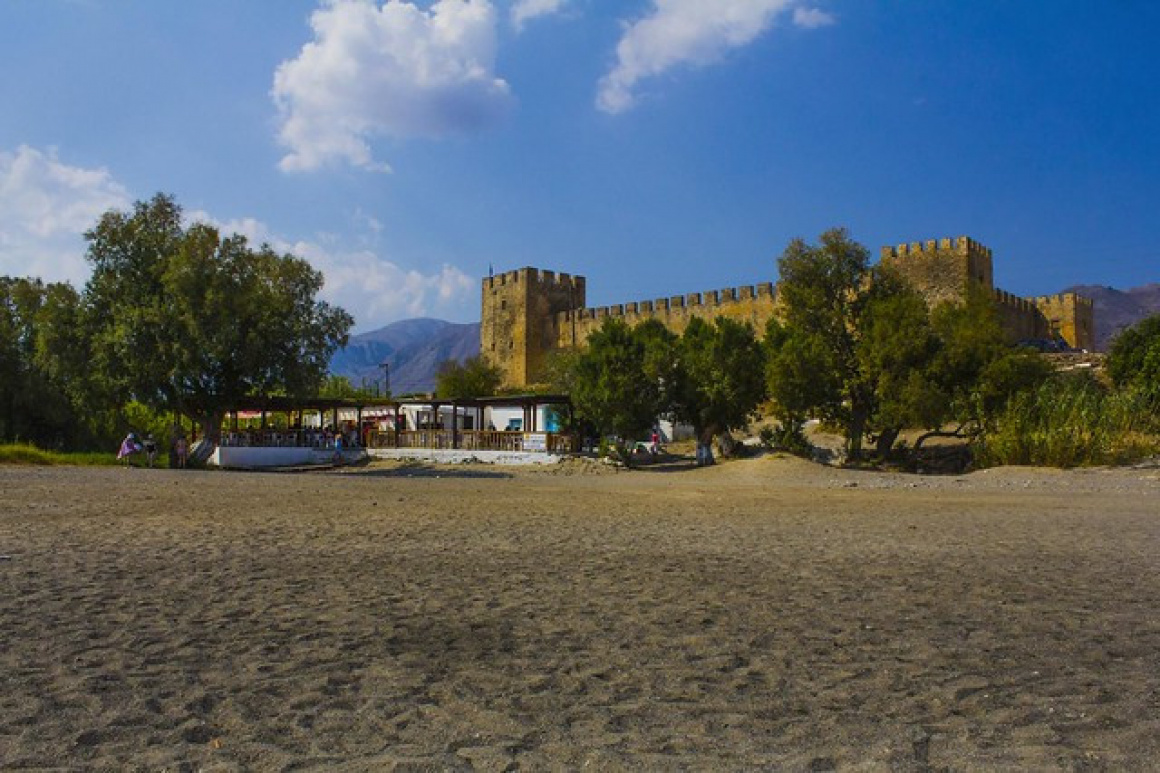The sturdy walls of Frangokastello's Venetian fortress stand guard over an empty plain, a silent witness to history, with the Libyan Sea just beyond. On a quiet stretch of southern Chania, where the Lefka Ori (White Mountains) slope down to meet the sea, lies Frangokastello – a place where history and myth blend under the Cretan sun. At first glance, Frangokastello is a simple seaside hamlet, notable for its 14th-century Venetian castle that sits just meters from the beach. The castle's massive stone walls rise from the sand, remarkably well-preserved, as if awaiting the return of medieval knights. It was built between 1371–74 by the Venetians, as a garrison to subdue the rebellious Sfakia region and to guard against pirate raids.
Yet, despite its imposing presence, Frangokastello today feels anything but warlike – it's serene, remote, and undeniably magical in the early morning light. In fact, it's famous across Crete for the legend of the Drosoulites (meaning “dew shadows”), ghostly apparitions of fallen warriors that locals say appear at dawn on humid late-May mornings. According to lore, these are the spirits of Greek fighters, led by Hatzimichalis Dalianis, who were slain in a fierce battle against Ottoman forces here in 1828. Many claim to have seen shadowy figures marching from the castle toward the sea during the anniversary of the battle, a phenomenon that science attributes to an optical illusion, but in Frangokastello's hush, you might just start believing in ghosts. Beyond its castle and legends, Frangokastello offers a stunning beach, a broad curve of fine sand shelving gently into shallow, turquoise waters. The scenery is framed by the backdrop of barren mountains, giving you the feeling of being on the edge of civilisation. Time moves slowly here. You'll find just a handful of family-run tavernas and a scattering of rooms to let. In the evenings, the castle battlements are beautifully illuminated, and you can dine on freshly grilled seafood literally in its shadow. If you've ever dreamt of having a medieval castle and a beach practically to yourself, Frangokastello is your place.

 'Frangokastello (Crete, Greece): the beach and the Venetian castle' - Attribution: Marc Ryckaert (MJJR)
'Frangokastello (Crete, Greece): the beach and the Venetian castle' - Attribution: Marc Ryckaert (MJJR)Seasonal Rhythms at Frangokastello
Frangokastello's seasons are pronounced, and knowing what to expect will help you plan the best time to experience its charm. Summer (July–August) is the busiest period, though “busy” is relative – even at peak, Frangokastello's beach never reaches the tourist crush of, say, Elafonissi Beach. You will see Greek families with young children splashing in the famously shallow waters (the bay stays knee-deep quite far out, making it an ideal natural kiddie pool). The sand can get toasty underfoot by midday, but a quick dip in the clear sea will cool you right off. Do note that occasionally strong southerly winds kick up in summer, sending fine sand blowing across the beach.
It's wise to secure your beach umbrella and perhaps choose a spot near the castle walls for a windbreak on blustery days. In spring (May–June), the region is at its most beautiful – wildflowers dot the arid landscape, and the weather is warm but not scorching. This is also when the Drosoulites legend comes alive (around late May). If you visit at dawn during this time, you might find a few hopeful souls gazing at the mist, waiting for ghostly soldiers to appear marching along the shore. Spring is wonderful for hiking in the nearby gorges (like Kallikratis or Aradena) and for exploring the quiet mountain villages of Sfakia before the heat sets in.
Autumn (September–early October) brings balmy days and bath-warm sea temperatures. The summer crowds have gone, and you might share the beach with just a handful of sunbathers. The sea breeze in September is gentler, and it's a pleasure to sit on the castle ramparts in the late afternoon, watching the sun dip behind the mountains. Swimming is still very much possible, in fact, locals often say the sea is at its warmest in early fall.
Winter (November–March) is the off-season, and Frangokastello becomes a windswept, almost forgotten outpost. Most tavernas and guesthouses close, but the castle itself stands open and free to wander. Visiting in winter can be atmospheric, imagine having this centuries-old fortress entirely to yourself, with waves pounding the shore and perhaps a stormy sky adding drama. Just come prepared, as facilities are scant, the nearest larger village, Chora Sfakion, is 12 km away and that's where you'd find the nearest ATM or pharmacy year-round. Many locals from Sfakia do day-trips here in winter for a brisk beach walk or to check on their properties, so you might encounter a friendly face or two even in the quietest months.
Where to Stay in Frangokastello
Accommodation in Frangokastello is low-key and blends into the landscape – think small family-owned hotels, studios, and tavernas with a few rooms. Here you won't find big chain resorts or high-rise buildings (thankfully!), instead, you get warm Cretan hospitality and the luxury of simplicity. Some recommendations:
Fata Morgana Studios & Apartments: A hidden gem named after the mirage-like phenomenon (fata morgana) akin to the Drosoulites legend. This lovely self-catering spot is just steps from Orthi Ammos beach, a gorgeous stretch famous for its sand dunes. The studios are modern and comfortable, with kitchenettes, great for independent travellers. Waking up here means hearing only the waves and maybe a distant goat's bell.
Paradisos Apartments: True to its name, this is a little “paradise” nestled in an olive grove. The apartments are simple but clean, many with stunning sea views from their balconies. It's an ideal choice for families or couples who want a peaceful base.
Monachus Monachus Apartments: A slightly larger property (though still very intimate), offering a pool and spacious apartments. It's located a short walk from the main beach. This is a good pick if you're travelling with kids. The pool is a nice alternative if the sea is a bit wavy, and the beach is only a 5-minute stroll. The name refers to the monk seal (Monachus monachus), an endangered species sometimes spotted in Crete's waters, perhaps a nod to the tranquil vibes here.
Keep in mind that places to stay in Frangokastello are limited. In July and August, it's wise to book ahead as many Greeks (and a handful of in-the-know foreigners) return annually, drawn by the area's peace. In the off-season, you might not find any formal accommodations open, but some owners in the nearby villages may rent out rooms if asked.
Getting to Frangokastello
Remote and rewarding, that's the journey to Frangokastello. Part of its untouched feel comes from the fact that it's a bit off the main tourist track. Here's how to reach this coastal castle haven:
By Car
Driving is the easiest way to get to Frangokastello and explore the surrounding region. From Chania city, it's about 80 km (approximately 2 hours) to the east and then south, you'll drive through the mountain roads of Sfakia. The most common route is via the spectacular Imbros Gorge road down to Chora Sfakion (Sfakia village), then another 15-minute drive east along the coast. The road is paved and in good condition. If coming from the east (i.e., from Rethymno direction), you can drive through the mountain village of Rodakino and over to Frangokastello, a scenic route that takes you past goat-dotted hills and sudden sea vistas. A car also lets you visit nearby sights like Plakias or the beautiful beach of Elafonissi Beach on a long day trip. Parking in Frangokastello is plentiful and free, you can literally park right outside the castle or your accommodation.
By Public Bus
During summer, KTEL (Crete's regional bus service) operates a limited bus route to Frangokastello. Typically, there's a daily bus from Chania that goes to Chora Sfakion and onward to Frangokastello, often timed in the morning with a return in the afternoon. The journey from Chania to Sfakia takes about 1.5 hours, and then it's another 20–30 minutes to Frangokastello. Keep in mind these buses are few, always check the latest timetable on the KTEL website or ask locally. If you're coming from Rethymno by bus, you'd usually take a Chania-bound bus and change at a junction like Vrysses to catch the Sfakia bus. Public transport will require some planning, but it's doable for determined travellers in peak season. In the off-season, buses to this area may not run at all.
By Boat
While there isn't a direct ferry to Frangokastello, the nearby harbour of Chora Sfakion has ferry connections along the south coast, to places like Loutro, Agia Roumeli, and Paleochora. If you are exploring Crete's south coast by ferry, you could disembark at Sfakion and then take a short taxi ride or local bus to Frangokastello. For example, some adventurers hike Samaria Gorge ending in Agia Roumeli, ferry to Sfakion, and then relax in Frangokastello to recuperate.
By Taxi
A taxi from Chania to Frangokastello is expensive given the distance, expect to negotiate a fare, but from Chora Sfakion it's quite reasonable. The local Sfakia taxis often wait for arriving ferries, and a ride to Frangokastello can be arranged on the spot or by phone. This might be a good option if you come by bus to Sfakia and just want to skip the wait for the onward bus.
Once in Frangokastello, getting around is straightforward, the beach, castle, and a few eateries are all within a short walk of each other. To visit the Vatalos and Orthi Ammos beaches on either side of the main bay (each a 10–15 minute walk), you can amble along the shore. For anything further, such as trips up to the mountain villages or east towards Monastery of Preveli, having your own vehicle is beneficial. However, many visitors find that “doing nothing” is the best agenda here, just soaking up sun and legends in one of Crete's most evocative locales.
Frangokastello lies in the Chania Prefecture, and it's just one facet of Chania's diverse attractions. After experiencing the solitude here, you might venture to the bustling Chania Town to enjoy its Venetian Harbour and nightlife, or, a short drive west takes you into the rugged heart of Sfakia – noted for its gorges and proud villagers, truly a different world compared to the rest of Crete.
To find your perfect hotels in Frangokastello and around the world, we’ve built Travelmyth, the innovative hotel search engine with a wide range of category filters. From romantic hotels in Tampa to hotels near golf courses in Brighton & Hove, Travelmyth is the go-to source for hotel-related information.

